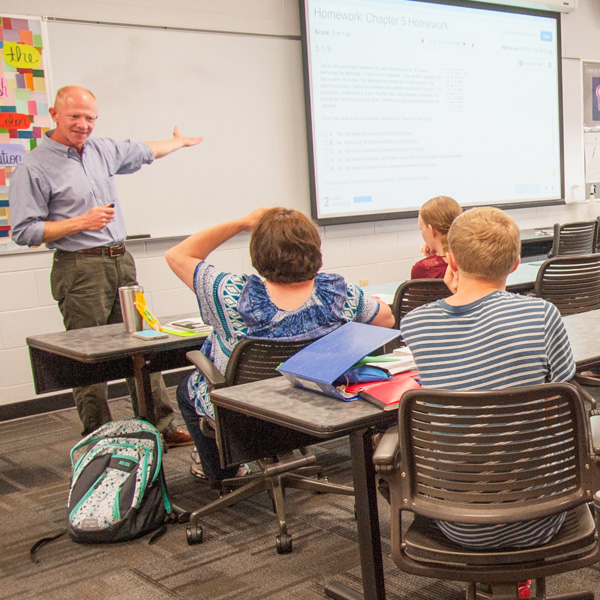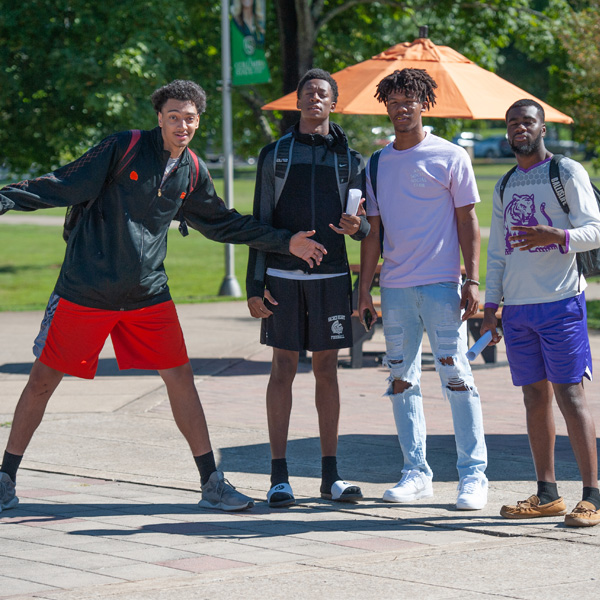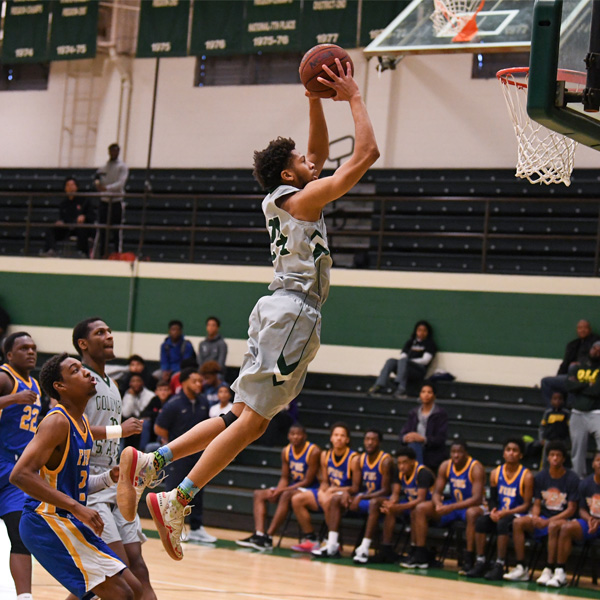Campus Safety
Since our founding in 1966, Columbia State has fostered a safe, nurturing environment on each of its five campuses. To that end, we constantly strive to anticipate all possible threats—no matter how unlikely—and provide our students, faculty and staff with information they may need to navigate an emergency or other dangerous situation.
This guide is designed to help you make the best decisions possible to protect yourself and those around you when the unexpected—and potentially life-threatening—happens.
The best first step in any emergency? Stay calm.
If you notice something or someone suspicious:
- Report it. Do not ignore your instincts. Call the police to report suspicious activity. Call 911 for emergencies.
- Never try to make contact, pursue or interfere with an individual or group whose behavior you consider suspicious.
If an active shooter is reported or encountered:
If you are outside a building near the threat, go to nearest cover immediately.
If you are inside a building:
- If there are no obstacles blocking an exit and you are reasonably sure the shooter is at another location, quickly exit the building and move to safety.
If you cannot safely exit the building, secure the area by following these tips:
- Lock and barricade doors.
- Stay away from doors or windows.
- Turn off lights.
- Block windows.
- Turn off radios and computer monitors.
- Keep yourself out of sight (take cover/protection from bullets by using concrete walls or filing cabinets).
- Silence your cell phone.
What to report to 911:
- Your specific location
- Number of people at your location
- Number of injured and types of injuries
- Assailant(s) – location, number of suspects, race/gender, clothing description, physical features, types of weapons, backpack, shooter’s identity (if known), separate explosions from gunfire, etc.
Be prepared for the police response:
- Follow all instructions given by police officers.
- Understand their first actions will be to address the threat.
- Make sure empty hands are in plain view.
If you receive a bomb threat:
- Stay composed.
- Get the attention of someone nearby and tell them to call the police (911) and Campus Security (931-797-9669) immediately.
- Keep the caller on the phone by asking the following questions:
Where is it right now?
What does it look like?
What kind of bomb is it?
What will cause it to explode?
Did you place the bomb?
What is your address?
What is your name?
- Relay information to police as soon as possible and follow their directions.
- Cooperate with the arriving emergency personnel while they evaluate the threat.
- Follow police (or emergency personnel) orders to evacuate your building.
- Activate the fire alarm to alert others if immediate evacuation is necessary.
If you encounter a fire:
- If the fire is small, try to extinguish it. (See below for fire extinguisher instructions.)
- Do NOT use an extinguisher if:
- Alert others and pull the closest fire alarm.
- Evacuate the building and stay low or crawl to stay below the smoke.
- Cover your nose and mouth to keep from inhaling the smoke.
- Do not use the elevator.
- Evacuate to a point at least 200 feet away from the building.
- Contact 9-911 and then Campus Security 9-797-7669
- Provide as much additional information as you can, such as where the fire (building name and address) is and if there are people inside.
- Do not re-enter the building until the fire department or police makes the ALL CLEAR announcement.
- Provide basic personal information to emergency response personnel for accountability.
- Pull the pin at the top of the extinguisher.
- Direct fire extinguisher toward the base of the fire.
- Squeeze the metal handles.
A medical emergency is any health-related event that is potentially debilitating or life-threatening. This includes heart attacks, seizures, auto accidents, loss of consciousness, large loss of blood, etc.
In the case of such an event:- Have someone call 911 (9-911 if from a campus phone) immediately. Relay all relevant information (building, room, address and the nature of the emergency). Do NOT hang up with the 911 operator until you are released.
- Contact Campus Security at 797-7669. (Dial 9 before # if from a campus phone.)
- Search the area for any hazards that may have caused the emergency or could be hazardous to first responders. This could include downed power lines, chemicals or motor vehicle traffic.
- If a trained person is available, first aid should be given.
- Have someone wait outside the building to escort emergency medical personnel to the scene.
1. CHECK and CALL
- CHECK the scene, then CHECK the person
- Tap on the shoulder and shout, “Are you okay?”
- CALL 911 if no response.
- If unresponsive and not breathing, BEGIN CHEST COMPRESSIONS.
- Occasional gasps are not breathing.
- Whenever possible, use disposable gloves when giving care.
- Place the heel of one hand on the center of the chest.
- Place the heel of the other hand on top of the first hand, lacing your fingers together.
- Keep your arms straight, positioning your shoulders directly over your hands.
- Push hard and push fast.
- Continue chest compressions.
- Except in one of these situations:
- You see an obvious sign of life (breathing).
- Another trained responder arrives and takes over.
- EMS personnel arrive and take over.
- You are too exhausted to continue.
- An AED is ready to use.
- The scene becomes unsafe.
If an AED is available:
- Turn on AED.
- Wipe chest dry.
- Attach the pads.
- Plug in connector, if necessary.
- Make sure no one is touching the individual.
- Push the “Analyze” button, if necessary.
- If a shock is advised, push the “Shock” button.
- Perform compressions and follow AED prompts.
Note: To avoid heat-related medical emergencies, you should avoid extensive sun exposure and strenuous activities, drink plenty of water, and wear light-colored, loose clothing.
Heat Exhaustion: Symptoms include heavy sweating; weakness; cold, pale and clammy skin; weak pulse; fainting; vomiting.
- Cool the victim rapidly from the shoulders down.
- Move to air-conditioned place if possible.
- Loosen clothing.
- Apply cool, wet cloths and fan the victim.
- Encourage victim to drink cool water, one tablespoon at a time.
- Seek medical follow up.
- If victim refuses water or if vomiting occurs, call 911.
- Call 911. Heat stroke is a severe medical emergency and can be fatal.
- Remove all hot, sweaty clothing
- Cool the victim rapidly, from the shoulders down, with cool but not icy water.
- Carefully move the victim to a cool, shady place.
- DO NOT FORCE FLUIDS if the victim is either unwilling or vomiting.
If severe weather is likely (winter storm, high winds, lightning, hail, flash floods):
- Monitor the weather for local conditions.
- Postpone outdoor activities.
- Avoid driving in conditions that make driving hazardous (ice, high winds, flash flooding, etc.)
- Seek appropriate shelter. (If there is a thunderstorm, remain there until thirty minutes after the last rumble of thunder.)
- Remember that sheds, tents and covered porches don’t protect from lightning!
- During a thunderstorm:
- Avoid high water, storm drains, ditches, ravines or tunnels.
- Don’t drive through a flooded road. Even a few inches of water can be deadly.
- If in class or at work, monitor campus notifications and follow the directions provided.
If a tornado warning is in effect:
- Facility Services will alert the campus through the phone system when threatening conditions exist.
- Note each building has a building coordinator who will help gather students and staff into the appropriate locations.
- Move to a shelter location, such as ground floor interior offices, bathrooms, stairwells or closets.
- Protect your head and neck. (Crouching beneath a solid piece of furniture, wearing a bike helmet or even using sturdy text books can work.)
- Stay away from windows and doors.
- Stay in your location until the ALL CLEAR signal is delivered, either over the P.A. system or via 2-way radio to the building coordinator assigned to each building.
- After receiving the ALL CLEAR signal, exit damaged buildings and go to a safe location.
- If you are outdoors and unable to find shelter, find a ditch or low spot where you can lie down.
- After the event, report your condition and location to emergency preparedness personnel or some other official.
If an earthquake occurs:
- In indoors, seek shelter under a sturdy desk. If no desk is available, move into a hallway or stand against an inside wall.
- Do NOT exit the building. Falling materials can be deadly.
- Do NOT run down stairs. Stay clear of windows and heavy appliances.
- When shaking has stopped, evacuate building and do not return until ALL CLEAR signal is given.
- When outdoors, move away from tall buildings, trees, utility poles or any structure that could collapse.
- After the event, report your condition and location to emergency preparedness personnel or some other official.
Important Numbers
Security
- 931.540.2700 (When using a campus phone, dial last 4-digits.)
Inclement Weather Line
- 931.540.2515
TDD Relay Number
- 1.800.848.0298
Police (Emergency)
- 911
Ambulance
- 911
Fire Department
- 911
Columbia Power & Water
931.388.4833 or
931.388.5616 after 5 p.m.
ATMOS Energy (Gas)
1.800.566.5469
Maury Regional Medical Center
1114 W. 7th St.
Columbia, TN 38401
931.381.1111
Williamson County Medical Center
4321 Carothers Pkwy.
Franklin, TN 37067
615.435.5000
Crockett Hospital
1607 S. Locust Ave.
Lawrenceburg, TN 38464
931.762.6571
Maury Regional Medical Center (Marshall County)
1080 N. Ellington Pkwy.
Lewisburg, TN 37091
931.359.6241
Wayne County Medical Center
103 Mangubat Dr.
Waynesboro, TN 38485
931.722.5411








